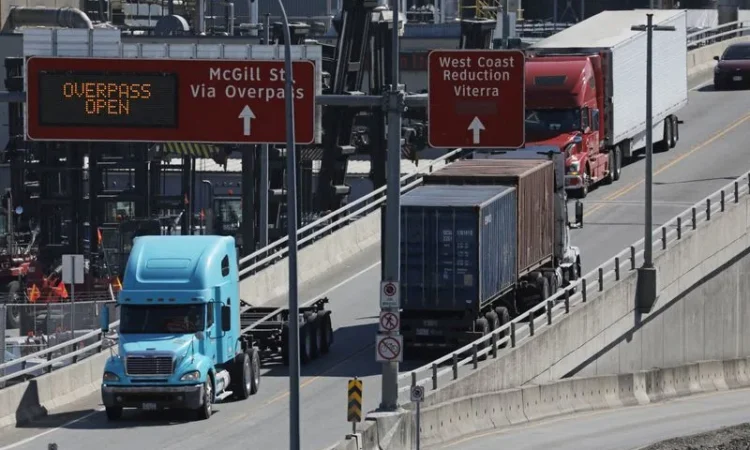TORONTO (Reuters) – Canadian truckers are struggling to make payments on their rigs as fuel prices rise and freight rates tumble, forcing banks to declare tens of millions of dollars’ worth of bad loans.
The big-five Canadian banks have transportation loans totalling nearly C$54 billion ($39.44 billion), according to quarterly filings as of April 30. That amount represents 3.4% of all business loans, a bigger portion than the 1.1% that oil and gas companies account for, by comparison.
As the financial solvency of borrowers, known as credit quality, becomes key in a high-interest-rate environment, Canada’s top banks say they are working to reduce bad loans by exercising more caution towards new borrowers.
The banks have benefited from a surge in investment banking and wealth management, but demand for loans to individuals and businesses is weakening.
Truckers bought new rigs to meet surging demand in the early pandemic, but freight rates have been stubbornly depressed since business normalized with the lifting of restrictions. As a result, truckers have struggled to make payments on loans for rigs and other equipment.
Only about one-fifth of truckers that entered the market during the pandemic are still operating, said Dean Croke, analyst at DAT Freight & Analytics. U.S. freight rates have steadily declined since April 2022 until increasing this week, he said.
Of the big-five banks, Bank of Montreal has the biggest exposure, with C$15 billion of transportation loans, of which C$305 million is impaired. That compares with C$91 million a year ago and C$230 million in impaired transportation loans in the first quarter.
BMO said part of its higher-than-expected loan-loss provisions during the second quarter came from the transportation sector.
“For the last 18 months, you’ve seen freight rates have remained at an all-time low, volumes haven’t picked up … And (truck) resale values because of oversupply have also been impacted,” Chief Risk Officer Piyush Agrawal said in May.
Agrawal said the number of delinquent loans is starting to flatten.
Bank of Nova Scotia has C$263 million in impaired loans within its C$9.2-billion transportation loan book, compared with C$55 million a year ago.
RBC’s impaired loans nearly doubled from the first quarter to C$116 million in the second quarter, out of its C$13.2-billion transportation loan book, as it integrated its HSBC Canada acquisition.
TD and CIBC hold C$62 million and C$10 million respectively in impaired loans out of C$8.9 billion and C$7.5 billion in transportation loans.
Provision for credit losses linked to transportation loans rose about 4% at the five banks combined in the second quarter from the prior quarter.
Edward Jones banking analyst James Shanahan expects the problem for some banks to persist for a couple more quarters.
Delinquencies on asset-based loans are the most in the last 20 years in Canada, driven by the transportation and retail industries, according to Equifax Canada data.
Asset-based loans include equipment leases that traditionally have lower-than-average delinquency, said Equifax’s head of commercial solutions Jeff Brown.
“The rise in missed payments strongly deviates from what would be expected, and may be cause for long-term concern,” Brown said.
Avery Vise, vice president at FTR Transportation Intelligence said the industry’s recovery will be shallow and prolonged, though the worst has passed.
In the United States, where some Canadian banks make loans, the number of carriers exiting the market appears to have peaked around the beginning of this year at an unusually high rate, Vise said.
“The recovery in trucking is certainly taking longer than most people expected, and therefore some of the assumptions that went into the financing might have been a little more optimistic than what has proved to be reality,” he said.
($1 = 1.3690 Canadian dollars)
(Reporting by Nivedita Balu in Toronto; Editing by Rod Nickel)


